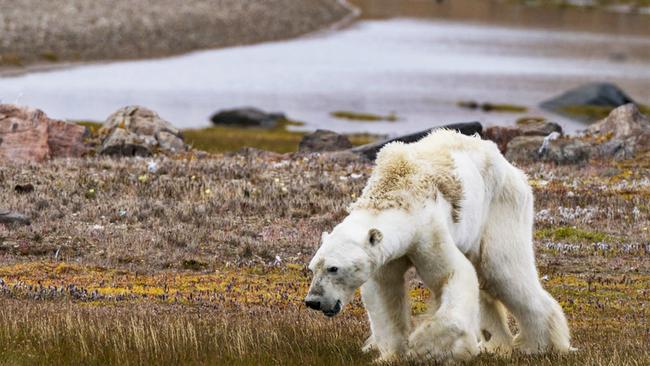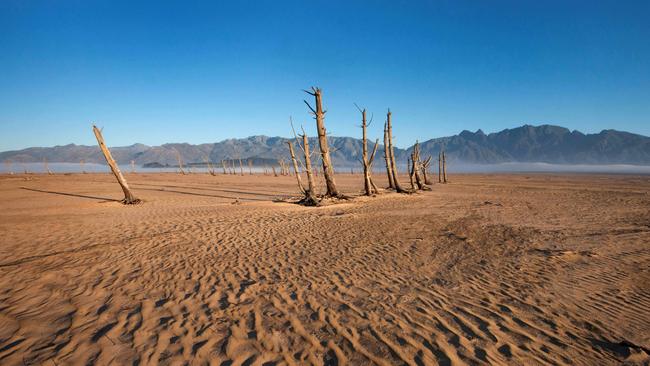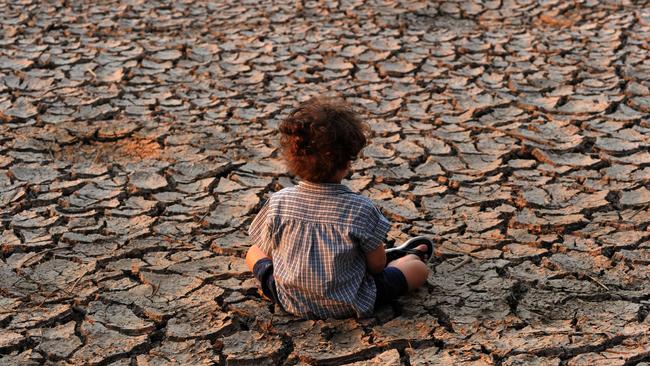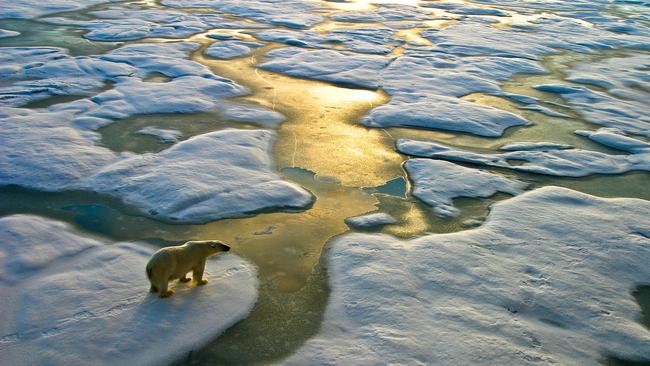When will global warming become too hot for humans to survive?
EXTREME heat has 27 ways to kill you. As South Australians swelter through another summer, scientists say the world will only get hotter – and we need to plan for worse to come. So how hot is too hot?

SA Weekend
Don't miss out on the headlines from SA Weekend. Followed categories will be added to My News.
EVEN by Australian standards, last summer was a scorcher. January 2017 was the hottest ever recorded in Sydney and Brisbane, and great swathes of the south-east endured temperatures that often exceeded 40C for weeks on end. In South Australia, soaring electricity demand caused an outage that left 90,000 homes sweltering through a blackout with no airconditioning. Across New South Wales, 87 bush fires blazed. It was so hot that dairy cows dropped dead in the fields.
This kind of heatwave isn’t a blip. It is part of a trend that saw Sydney’s temperature climb to over 47C earlier this month – the highest recorded in the city for 79 years – and could see both it and Melbourne experiencing mega-heatwaves with highs of 50C by 2040. “Going out to 40 or 50 years, basically the summer we just had will be normal,” says Sarah Perkins-Kirkpatrick at the Climate Change Research Centre of the University of New South Wales. “It hasn’t really sunken in yet in Australia.”
Australians are not alone. Most of the world is failing to take the “warming” in global warming seriously. If you live somewhere temperate, you might even welcome a rise of a few degrees as offering more opportunity for picnics, barbecues and relaxed afternoons in pub gardens. That is unwise. Even now, heatwaves are deadly, and as global warming increases so will the death rate. Human physiology is not designed to cope with the temperatures predicted for large swathes of the globe and many areas could become uninhabitable. Fortunately, there are things we can do to make our bodies and our environments better adapted to a warming world.

With a few notable exceptions, we are all aware that anthropogenic warming has widespread and sometimes severe consequences, so it is somewhat surprising that we are only just waking up to the fact that it can kill us. This oversight doesn’t stem from lack of evidence. In the US, extreme heat caused more fatalities between 1978 and 2003 than earthquakes, hurricanes, floods and tornadoes combined.
By some estimates, the 2003 heatwave centred on France killed more than 70,000. Another that struck Moscow in 2010 resulted in 10,000 deaths.
In October, The Lancet published a report featuring research by 26 global institutions including the World Health Organization and World Bank, which concluded that we face a “looming public health emergency”.

This came hot on the heels of research looking specifically at “lethal heat”. Already, 30 per cent of the world’s population experiences potentially deadly temperatures for at least 20 days every year.
A team led by Camilo Mora at the University of Hawaii in Manoa reported in June that this will rise to nearly 75 per cent by 2100 if we do little to limit greenhouse gas emissions.
So how hot is too hot?
What matters is not the air temperature, but the temperature you experience.
You can survive for a while at well above 50C, as long as you can sweat effectively. The problem is humidity.
“The only way you lose heat when you sweat is by turning liquid into vapour. It has to evaporate,” says Graham Bates at Curtin University in Western Australia. “With a humidity of 90 per cent, the air is almost saturated, and when you sweat it just drips off, and you won’t lose heat.”
The combined effect of heat and humidity, otherwise known as the apparent temperature, can be gauged using a “sweating” thermometer, one wrapped in a damp cloth. A “wet bulb temperature” of 35C – equivalent to an ambient temperature of 35C and 100 per cent humidity or 40C and 75 per cent humidity – is considered the limit for human survival. Above this, even a healthy person in the shade won’t live longer than six hours. Nowhere on earth has experienced it yet, although Bandar Mahshahr in Iran got very close in July 2015 with the conjunction of 50 per cent humidity and 46C.
But it is only a matter of time.

“Both temperature and humidity are going up,” says Steven Sherwood, an atmospheric scientist at UNSW. The highest risk is in places that are already humid, such as the Amazon, the Indus Valley and many tropical countries. “It only takes a 6C to 7C increase in temperature before some of these regions become physically uninhabitable,” says Sherwood. He says unless we drastically reduce global warming some regions will exceed this limit in 100 to 200 years.
This may even be an underestimate. Research published in August 2017 showed that parts of India, Pakistan and Bangladesh could occasionally exceed a wet bulb temperature of 35C by the end of this century.
This region is home to 1.5 billion people, about a fifth of the world’s population, most of whom are poor and exposed to the full force of lethal heat. Subsistence farmers will be disproportionately affected by crop failures.
Yields of wheat, rice and maize – which together with soy generate nearly two-thirds of all calories consumed by people – are forecast to fall by between 3 and 7 per cent for each 1C rise in global temperatures. And, in a double whammy, rising temperatures also impact the productivity of rural labourers. Since 2000, global warming has effectively reduced the workforce in India by 418,000, according to The Lancet report.
What’s more, even temperatures below the theorised limit for human survival could render places uninhabitable, and we will reach this long before the end of the century. In fact, the US National Weather Service classifies any wet bulb temperature above 31C as “extreme danger”. That’s because your body produces its own heat.

At rest, it generates some 100 watts, about the same as a small incandescent light bulb. During brief bursts of intense exercise, such as running, however, it can produce more than 1000 watts, equivalent to the heat produced by a microwave oven.
“Muscles in humans are extremely inefficient,” says Bates. When you burn fuel in the engine of a car, about 60 to 70 per cent of it goes to turn the wheels. Our muscles, on the other hand, lose 90 per cent of their energy as heat. “The minute you start walking or running in the heat, then you take on a heat load which has to be dissipated to the environment,” he says.
Turning up the heat
The optimum body temperature for a human is between 36.5C and 37.5C. This is where your metabolism, specifically your enzymes and other proteins, function most effectively.
Millions of years of evolution on the African savannah have honed sophisticated cooling systems to keep our core within this narrow range. When the mercury rises, thermoregulation occurs both consciously – in behaviours such as removing clothing, drinking water and fanning ourselves – and unconsciously through the autonomic nervous system.
The unconscious system is triggered by thermoreceptors in the skin, muscles, stomach and other areas detecting changes in temperature. These alert the thermostat in the brain, the hypothalamus, which then sets in motion responses including sweating and shunting blood to the surface, where it can more easily lose heat to the environment.
However, to sweat effectively you must maintain your blood volume. If you become dangerously dehydrated, or another part of the system fails, then your body temperature will start heading towards 40C. At this point, you go from heat stress – where your skin appears red and sweaty – to heatstroke, where you suddenly become white with skin that is dry to the touch. This happens because blood is being diverted back to the vital organs in an attempt to limit damage due to the lack of oxygen, or “hypoxia”, caused by the blood circulating close to the skin.
“About 70 per cent of the people that get into that situation will die or have multiple organ failure,” says Bates.
Deaths from overheating are often simply recorded as heart failure, because the heart must work overtime pumping blood to the extremities, but hypoxia is another common cause of death, says Mora.

In fact, his team has identified at least 27 ways heat can kill. “One of the main ones is your gut,” he says. “The blood goes to the skin, and several organs are deprived of blood, including the intestines.”
Hypoxia is particularly damaging in the gut, because it can cause the lining to disintegrate, releasing the intestine’s contents into the bloodstream and triggering a catastrophic immune response. This consists of a massive production of white blood cells that leads to clotting in major organs. The breakdown of muscles is another major killer because long myoglobin molecules unravel and travel via the blood, eventually clogging organs such as the kidneys, liver and lungs.
Elderly people are particularly susceptible to heatstroke because they often have weak hearts and their skin is less effective at sweating. Children are at greater risk too as their smaller bodies take less time to heat up and they have a larger surface-area-to-volume ratio, meaning they absorb heat more readily. People on medications are also vulnerable. “Some drugs impair the capacity of the body to perceive the dangers of heat,” says Mora.
Nevertheless, our bodies are remarkably able to acclimatise – provided humidity is low enough to allow effective sweating. It takes about a week of exposure before the thermoregulatory system starts to adjust.
Then, you begin to sweat earlier and more profusely in response to heat, and your sweat composition changes, so you lose less of the sodium and potassium electrolytes that maintain blood volume.

Of course, there are also ways to adapt behaviour to reduce overheating. Given enough time, humanity might even evolve to better endure extreme heat. We already possess the raw material for evolution to work with. There is substantial variation between people in how much they sweat, as well as in the number and density of their sweat glands.
Even so, there is little chance we could adapt to cope with a wet bulb temperature of 35C without hardier proteins able to function at a higher optimal temperature. And that would require significant changes to our basic biology.
Time is not on our side, but if we cannot adapt our bodies, we can at least adapt our environment to reduce the impact of rising temperatures. Heatwaves are often most intense in cities, where asphalt and the dark roofs absorb more of the sun’s rays and create a “heat island” effect. Urban planners rarely consider this, even in hot, wealthy places, such as Melbourne or Abu Dhabi. But there are simple things they could do.
“We need to design our homes better. That’s a starting point,” says Perkins-Kirkpatrick. She would like to see more white roofs to reflect sunlight and better insulation and double glazing so that, even without airconditioning, our homes are places we can retreat to in extreme conditions. Cities also need more shady, green spaces to help minimise the heat island effect.
A trailblazer here is New York City, which has taken on a massive regreening program in Manhattan over the past few years. The creation of airconditioned public refuges is another option that was discussed widely during last summer’s heatwave in Australia.

Such measures would have an added benefit. In developing countries, where power supplies are already precarious, rising temperatures will inevitably lead to more outages – even wealthy countries struggle to meet extra demand during heatwaves, as the authorities in South Australia were shocked to discover last February.
In addition, heat causes problems with electricity transmission by making cables expand and sag. Better-designed homes, greener public spaces and communal refuges would all ease pressure on electricity grids struggling to cope during heatwaves. That, in turn, would result in lower greenhouse gas emissions.
This matters because with a temperature rise of just 1.5C to 2C – as agreed under the 2016 Paris climate change deal – summer in parts of Australia will effectively become one long heatwave by 2100. Some tropical regions could go into a semi-permanent heatwave state, Perkins-Kirkpatrick has found.
And the situation will be far worse if greenhouse gas emissions are not curbed. She foresees “devastating impacts if anthropogenic climate change is not constrained as soon as possible”.
The heat could be well and truly on. ●
© 2018 New Scientist Ltd.


